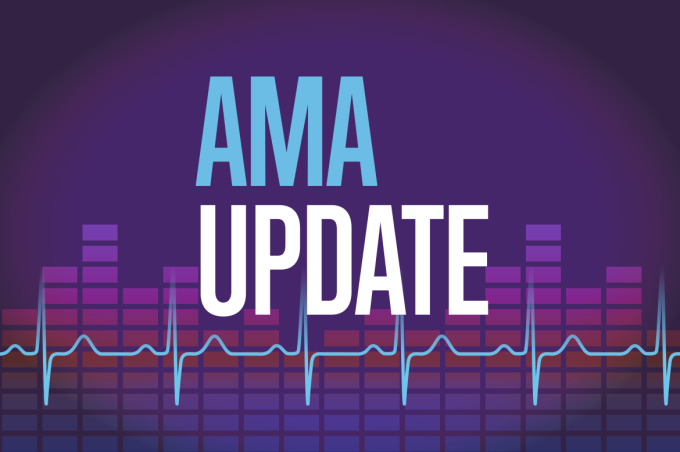Editor’s note: This article was updated in October to reflect the CDC’s decision to expand the use of bivalent COVID-19 vaccines to children 5 or older. The move followed the FDA’s authorization of updated vaccines from Pfizer-BioNTech for children 5–11, and from Moderna for those 6–17 years old.
An updated COVID-19 booster vaccine designed to better match the elusive Omicron BA.4 and BA.5 subvariants has arrived in time for fall.
“Bivalent” means it is half original strain, half Omicron BA.4, BA.5, explained Sandra A. Fryhofer, MD, chair of the AMA Board of Trustees and liaison to the Centers for Disease Control and Prevention (CDC) Advisory Committee on Immunization Practices (ACIP).
BA.5 makes up nearly 90% of all circulating COVID-19 strains. The Food and Drug Administration “is hoping this new bivalent booster will be a good match against circulating strains,” said Dr. Fryhofer.
The only bivalent boosters authorized are mRNA versions manufactured by Pfizer-BioNTech and Moderna. The U.S. government has bought 171 million bivalent vaccine booster doses—66 million from Moderna and 105 million from Pfizer.
This is the first time mRNA vaccines have been updated. Patients, however, have to meet certain requirements to receive them. During an episode of the “AMA Update” video and podcast, Dr. Fryhofer drilled down to the basics to help physicians answer the most common questions they will get from patients about the new booster.
Who is eligible?
About 230 million Americans are eligible for a bivalent COVID-19 vaccine booster. Pfizer's bivalent booster is authorized for those 5 or older, while Moderna’s authorization is for patients 6 and up.
Patients must complete a primary COVID-19 vaccine series before getting the booster.
The recommendation is that people should wait at least two months from their last COVID-19 vaccine dose to get a bivalent booster. Most people eligible for a booster are at least six months from their last dose, said Dr. Fryhofer.
Should I get boosted if I've already had COVID-19?
Patients with a prior COVID-19 infection are eligible. But they should wait until they’ve fully recovered from acute illness and are out of isolation.
The CDC advises that it's probably best to wait at least three months after a COVID-19 infection to get the booster. “But again, you must have completed a primary COVID vaccine series to be eligible,” noted Dr. Fryhofer.
Is the testing process for these vaccines a concern?
Human data does exist on bivalent COVID-19 vaccines with beta and Omicron strains. The Omicron booster study found that adding a second COVID virus to the original vaccine broadened the antibody response. Among people with prior COVID infection, the bivalent vaccines yielded the highest antibody titers.
These human studies targeted BA.1, a strain that’s no longer circulating, said Dr. Fryhofer. “That's why FDA directed the manufacturers to make a booster targeting the BA.4, BA.5 spike protein.”
Changing strains for an already studied vaccine isn’t new, she continued. “FDA allows changes in flu vaccine as the flu virus evolves without requiring a full efficacy trial. This is the same of type of thing,” she said.
The updated booster has only been tested on animals, not people. “There's no clinical trial data specifically for bivalent BA.4, BA.5 boosters in humans yet, but there will be,” said Dr. Fryhofer.
What are the side effects?
“Like other COVID vaccines, bivalent vaccines are reactogenic,” said Dr. Fryhofer.
The bivalent studies listed fatigue, headache, muscle and joint aches, chills, nausea, vomiting and fever as the most common side effects.
“There are some subtle differences in mutations between BA.1 and the BA.4, BA.5 spike protein sequences. However, experts do not anticipate any differences in safety or reactogenicity, based on these limited mutations,” she added.
Researchers reported no cases of pericarditis or myocarditis.
Can I get a COVID booster and flu shot at the same time?
The CDC says it’s safe to get a flu shot at the same time as any SARS-CoV-2 vaccine. Because the two viruses will be circulating at the same time, the CDC encourages it.
It’s also acceptable to get a SARS-CoV-2 vaccine or booster with other needed vaccines.
There’s just one exception—monkeypox, noted Dr. Fryhofer. ACAM2000 and JYNNEOS are the two available vaccines for this disease. ACAM2000 has been linked to myocarditis, a heart condition associated with COVID vaccines in young males. Myocarditis risk in JYNNEOS is unknown.
“If you've received a dose of either of them, CDC suggests waiting for four weeks to get a COVID vaccine dose. However, if you've already received a COVID vaccine dose and you're now at risk of monkeypox due to exposure, no need to wait,” she noted.
Do I have to pay a fee to get a booster?
These vaccines are free to patients, at least for now, said Dr. Fryhofer. “Both Moderna and Pfizer agreements include options for more doses but this would require more funding from Congress.”
The AMA recognizes the critical importance of scientific integrity, transparency and public trust in the fight to contain the global spread of COVID-19. Stay updated with the AMA on COVID-19 and vaccine development.
“AMA Update” covers health care topics affecting the lives of physicians and patients. Hear from physicians and experts on public health, advocacy issues, scope of practice and more—because who’s doing the talking matters. You can catch every episode by subscribing to the AMA’s YouTube channel or the audio-only podcast version, which also features educational presentations and in-depth discussions.




